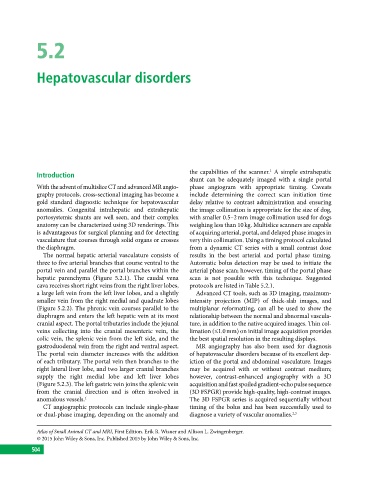Page 514 - Atlas of Small Animal CT and MRI
P. 514
5.2
Hepatovascular disorders
1
Introduction the capabilities of the scanner. A simple extrahepatic
shunt can be adequately imaged with a single portal
With the advent of multislice CT and advanced MR angio phase angiogram with appropriate timing. Caveats
graphy protocols, cross‐sectional imaging has become a include determining the correct scan initiation time
gold standard diagnostic technique for hepatovascular delay relative to contrast administration and ensuring
anomalies. Congenital intrahepatic and extrahepatic the image collimation is appropriate for the size of dog,
portosystemic shunts are well seen, and their complex with smaller 0.5–2 mm image collimation used for dogs
anatomy can be characterized using 3D renderings. This weighing less than 10 kg. Multislice scanners are capable
is advantageous for surgical planning and for detecting of acquiring arterial, portal, and delayed phase images in
vasculature that courses through solid organs or crosses very thin collimation. Using a timing protocol calculated
the diaphragm. from a dynamic CT series with a small contrast dose
The normal hepatic arterial vasculature consists of results in the best arterial and portal phase timing.
three to five arterial branches that course ventral to the Automatic bolus detection may be used to initiate the
portal vein and parallel the portal branches within the arterial phase scan; however, timing of the portal phase
hepatic parenchyma (Figure 5.2.1). The caudal vena scan is not possible with this technique. Suggested
cava receives short right veins from the right liver lobes, protocols are listed in Table 5.2.1.
a large left vein from the left liver lobes, and a slightly Advanced CT tools, such as 3D imaging, maximum‐
smaller vein from the right medial and quadrate lobes intensity projection (MIP) of thick‐slab images, and
(Figure 5.2.2). The phrenic vein courses parallel to the multiplanar reformatting, can all be used to show the
diaphragm and enters the left hepatic vein at its most relationship between the normal and abnormal vascula
cranial aspect. The portal tributaries include the jejunal ture, in addition to the native acquired images. Thin col
veins collecting into the cranial mesenteric vein, the limation (≤1.0 mm) on initial image acquisition provides
colic vein, the splenic vein from the left side, and the the best spatial resolution in the resulting displays.
gastroduodenal vein from the right and ventral aspect. MR angiography has also been used for diagnosis
The portal vein diameter increases with the addition of hepatovascular disorders because of its excellent dep
of each tributary. The portal vein then branches to the iction of the portal and abdominal vasculature. Images
right lateral liver lobe, and two larger cranial branches may be acquired with or without contrast medium;
supply the right medial lobe and left liver lobes however, contrast‐enhanced angiography with a 3D
(Figure 5.2.3). The left gastric vein joins the splenic vein acquisition and fast spoiled gradient‐echo pulse sequence
from the cranial direction and is often involved in (3D FSPGR) provide high‐quality, high‐contrast images.
anomalous vessels. 1 The 3D FSPGR series is acquired sequentially without
CT angiographic protocols can include single‐phase timing of the bolus and has been successfully used to
or dual‐phase imaging, depending on the anomaly and diagnose a variety of vascular anomalies. 2,3
Atlas of Small Animal CT and MRI, First Edition. Erik R. Wisner and Allison L. Zwingenberger.
© 2015 John Wiley & Sons, Inc. Published 2015 by John Wiley & Sons, Inc.
504

